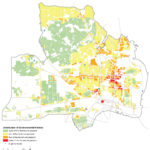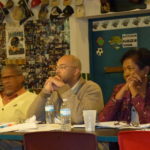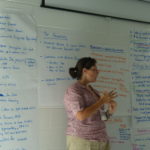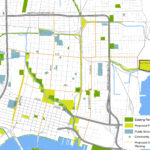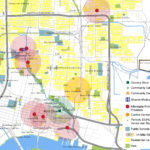Location: Jacksonville, FL | Client: EPA Region 4 and SRI| Project Date: June 2014 – April 2016
Project Images
Links and Resources
Jacksonville Integrated Planning Handout (4 pages)
Jacksonville Integrated Planning Report (42 pages)
Jacksonville Strategies: Innovative Approaches to Meeting Community Priorities (18 pages)
Project Description
Situation
Health Zone 1 in Jacksonville, FL demonstrates dramatic and measurable environmental justice disparities across economic, health and environmental indicators. The median income of Health Zone 1 is almost half that of Duval County as a whole. Residents of Health Zone 1 have significantly higher rates of health conditions such as diabetes, asthma and heart disease. Limited access to affordable healthcare, healthy food and health and wellness resources likely contribute to this disparity. Additionally, a history of industry and neglect has led to significant contamination and pollution in the area. Seven Superfund sites are located in Health Zone 1.
Solution
The Jacksonville Integrated Planning Process (JIPP) used a model for community engagement to build local capacity to address long- standing environmental justice concerns. The four project phases addressed stakeholder involvement, shared learning, solutions development and implementation. During the shared learning phase, the project team used GIS analysis to develop “heat maps” of cumulative risk to identify neighborhoods in most need. Using principles from Policy Link, ICLEI’s Star Community Index, and the Ford Foundation, Skeo created a set of guiding principles for this model integrated planning process:
- Identify community-based quality of life priorities.
- Develop neighborhood-based solutions.
- Strengthen a coalition of neighborhoods.
- Prioritize, coordinate and leverage resources based on community need.
- Evaluate all forms of community capital.
- Build strong “urban villages” and community cores.
Outcome
The JIPP project team worked with residents and local community organizations to identify three main goals: improve access to healthcare, open space, and healthy food. Project participants have formed work groups and are taking steps to build a sustainable coalition to advance and support these goals. As a result of this work, the LISC EPIC Communities project has agreed to align investments with these community goals and has enlisted JIPP community leaders in the new LISC Advisory Group to guide investments. A specific goal of this process was to increase the capacity of the Eastside environmental justice neighborhoods by building partnerships with the adjacent, more resourced Springfield neighborhood. This partnership resulted in National Parks Service funding to establish a Groundwork Trust for park and creek improvements and programming to benefit both communities.

